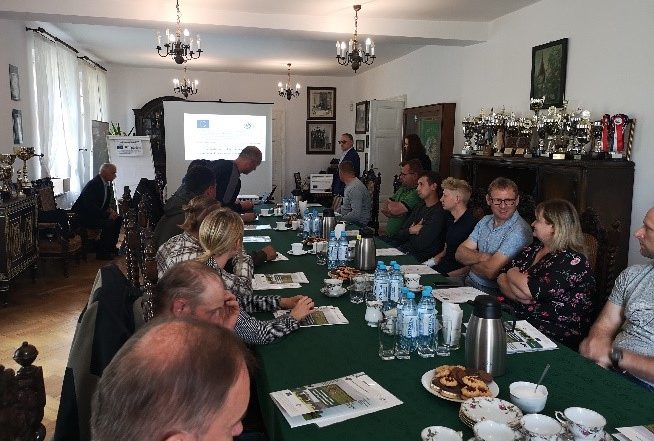A visit by breeders from the Lubuskie Voivodeship to a demonstration farm in Przyczyna Górna as part of the implementation of sub-measure 1.2 “Support for demonstration projects and information activities” of the Rural Development Programme 2014–2020 on “Modern technologies for breeding and raising beef cattle”.
The training of farmers from the Lubuskie Voivodeship at a demonstration farm in the village of Przyczyna Górna is part of the implementation of sub-measure 1.2 “Support for demonstration projects and information activities” of the Rural Development Programme 2014–2020 on modern technologies for breeding and raising beef cattle. The operation is co-financed by the European Union with funds from the European Agricultural Fund for Rural Development (EAFRD).
The topic of the demonstration carried out at the Osowa Sień Animal Breeding Centre farm in Przyczyna Górna in the Lubuskie Voivodeship was “The use of the permanently fenced grazing sector in the year-round improvement of beef cattle welfare”. The aim of the demonstration, which will take place over three meetings at the facility, is to show the effective management of a beef herd using the permanently fenced grazing sector as a summer and winter yard. In addition, to indicate the possibility of increasing the fattening rate of cattle through the use of correctly balanced rations and increased welfare of cattle in a free-stall, deep litter system.

This is another meeting at the farm specializing in breeding purebred Limousin beef cattle. The beginning of the breeding dates back to 2016, when the first 15 in-calf heifers were brought to the farm from domestic breeding, and a year later another 15 were additionally purchased – already from French breeding. The breeding facility is located in the village of Jędrzychowice (Wschowa County), where approximately 10 ha of pasture and two livestock buildings are available. The cattle are kept during the grazing season (May to November) in separate paddocks, from 6:00 a.m. to 6:00 p.m. or around the clock in three paddocks ranging in size from 2.5 to 3 ha. The animals have free access to a deep straw barn. Suckler cows with calves, in-calf heifers and bulls are grazed. Pastures are established on arable land owned by the farm. The distance of the pastures from the farm does not exceed 100 metres, which is undoubtedly a big advantage of this farm. During the winter, the animals are kept in a winter pasture with unrestricted access to a free-stall barn on deep litter. Year-round feeding is based on feeding groups and including TMR. Feed is distributed once a day. There is harem, seasonal mating based on two bulls replaced in the herd every 5 years and sourced from pedigree breeding. Mating takes place from May to August, while 50% of births take place naturally, without the help of handlers, in January and February.
The farm has been successively implementing its own breeding programme for the herd for a number of years, which has resulted in valuable females being added to the herd every year, as well as a small number of offspring going to market. The demonstration, which began a series of meetings with farmers on 14 June 2023, consisted of a theoretical part followed by a practical part. During the theoretical part, Jan Pabierowski, President of Osowa Sień Animal Breeding Centre, not only welcomed the course participants, but also talked about the centre’s many years of operation, future plans and prospects for further development of Limousin cattle breeding.




The subject of the organization of breeding and reproduction on the farm was then discussed, with particular attention paid to the practical aspects of improving animal fertility and health. In this part of the meeting, the main issues of beef cattle breeding were also presented and discussed by an employee of the National Research Institute of Animal Production – the scientific supervisor of the demonstration, Dr Piotr Wójcik, Professor of the NRIAP. The subject of rational and monitored cattle grazing on small paddocks, maintenance practices and the necessity of their renovation was discussed. Attention was drawn to the role of pastures in maintaining high animal health, especially when the main feeding is based on roughage fed in the form of TMR. The presenter discussed the important role of unrestricted access to water and 24-hour monitoring of microclimatic conditions in the pasture and barn. The topic of thermal stress and the effects of thermal stress in terms of improving the welfare of beef cattle and as a consequence of its increased water intake by the animals was presented. Reference was made to the aspect of health and economic effects when heat stress occurs and the role of shaded areas (tree stands in the grazing area) in improving animal welfare.
The discussion also covered the selection of beef breeds, crossbreeding methods and the production effects of such measures. New and innovative solutions used in beef cattle breeding were presented, such as chipping, boluses, health detection, thermal stress monitoring, etc., as well as an important aspect of the principles of safe work with beef cattle. The present possibilities of continuous monitoring of animals through the use of the aforementioned subcutaneous chips in cattle with a temperature measurement option were pointed out, as well as a system for assessing the dirtiness of animals and a system for assessing animal condition.
During the practical part, which took place at the farm in Jędrzychowice, while visiting different cattle grazing paddocks and observing the grazing herd, the participants learned about methods for efficient and inexpensive permanent pasture fencing, the role of mobile fencing systems, the system for watering cattle and the distribution of TMR feed directly on the paddocks. The topic of the forthcoming drought, methods to counteract it, its impact on pasture planning and methods for watering cattle while grazing also came up in the discussions. Small-scale retention and the need for rainwater harvesting were discussed. After learning about the farm, the demonstration participants reconvened in the lecture room in Przyczyna Górna, where they were able to discuss further meetings in this area with the project supervisors.
